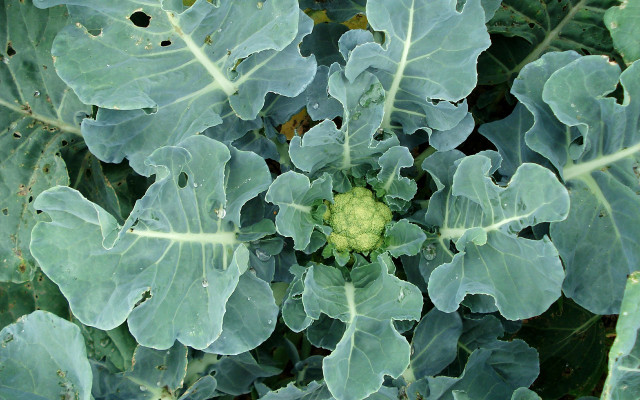A healthy addition to any diet, cauliflower has long been a traditional favorite the world over since the 13th Century. Find out here how to plant cauliflower in your own garden and what to look out for when growing this versatile vegetable.
Cauliflower derives its name from the Italian word cavolfiore, which literally means cabbage flower. Cauliflower is a member of the same plant species that includes kale, collard greens, broccoli, Brussels sprouts, and other types of cabbage. The earliest historical mentions of cauliflower were recorded in the Middle Ages, with Arab botanists suggesting the plant’s origin was from the Mediterranean island of Cyprus. The common European annuals harvested in the US today come from a strain developed in Germany in the 1700s.
The taste of cauliflower is described as nutty and a little sweet. It has a crisp and crunchy texture, with a mild enough flavor that blends with a huge range of hot and cold dishes.
When to Plant Cauliflower
Cauliflower reaches its earliest maturity around 7 to 12 weeks after transplanting the seedlings. In the northern hemisphere, most sources recommend fall season plantings in July, to enable harvesting before the first autumn frost. However, you can also plant your cauliflower in the spring so it’s ready to harvest before the summer heat. Northern European cauliflower plants are predominantly used in Europe and North America for summer and fall harvest.
Because the weather is a limiting factor for producing cauliflower, the plant grows best in moderate daytime temperatures of 70–85 °F with lots of sun and moist soil that is high in organic matter.
How to Grow Your own Cauliflower Plants at Home
You can either grow your own plants from seed or plant cauliflower seedlings.

Growing Cauliflower Plants from Seeds
- Seeds should be grown indoors for about four weeks before transplanting outside.
- Plant the seeds about 1/2 inch deep and 2 inches apart.
- Keep the soil moist.
- The seeds will sprout faster if kept warm, around 65–70 °F is ideal.
Planting Cauliflower Seedlings
Whether you plant your own cauliflower seedlings or those purchased from a store, always be careful not to damage the roots before you transplant them.
- Space the seedlings 20 to 26 inches apart in the soil, this will allow the leaves of your cauliflower plants enough space to grow.
- Pots or any type of large container that has good drainage for the plants can be used if you don’t have a big garden.
- Applications of organic, nitrogen-rich fertilizer like compost mixed with coffee grounds and a little manure is ideal for developing seedlings. Fertilizing once or twice during the plant’s life is enough. Any more might damage the cauliflower stems, so don’t overdo it.
Planting Cauliflower: Pest Control Tips
The most common pests that can affect cauliflower plants are aphids, root maggots, moths, and beetles. The plant is also susceptible to rot and mildew if soil and weather conditions are too damp. To deter pests organically, planting pole beans such as Kentucky Blue beans along with your cauliflower is an ideal solution – both plants will deter damaging insects and will also attract beneficial ones.



Row covers for your cauliflower plants will not only protect against frost, they will also keep cabbage worms, root maggots, and beetles at bay. Cabbage worms can also be picked off by hand and aphids can be sprayed off with a stream of water followed by neem oil. There is no need for heavier chemical alternatives to keep pests under control.
Harvesting
When cauliflower is mature, heads will appear clear white, compact and 6–8 inches in diameter. Upon harvesting, ideally the vegetable should be cooled for optimal preservation. Excluding refrigeration, short-term storage is possible using cool, high-humidity storage conditions such those found in a cellar or basement.
Cauliflower Varieties: Plant This Italian Spin on an Old Favorite
Aside from the classic white cauliflower most common in your local supermarket, a fun alternative to plant in the garden is Romanesco broccoli also known as Roman cauliflower or simply Romanesco.
It is a striking-looking plant that is yellowish/green in color, with floral heads that grow in a natural fractal geometry. It offers a nuttier flavor and firmer texture when compared to the common white variety. And like its cauliflower cousin, Romanesco is rich in Vitamin K, Vitamin C, carotenoids, and dietary fiber.
A Versatile Part of Many Dishes



So now that you know how to plant your own cauliflower – how do you use it? Cauliflower is a low-calorie, gluten-free alternative to rice and flour that is becoming ever more popular. Between 2012 and 2016, cauliflower production in the US increased by 63% and cauliflower-based product sales increased by 71% between 2017 and 2018.
Cauliflower rice, cauliflower pizza crust made using cauliflower flour, and mashed cauliflower as an alternative to mashed potatoes, are all simple recipes and easy to prepare at home. And did you know you can even make bread from cauliflower?
Cauliflower heads also can be roasted, grilled, boiled, fried, steamed, pickled, or eaten raw.
Important Information regarding Health-related Topics.
** Links to retailers marked with ** or underlined orange are partially partner links: If you buy here, you actively support Utopia.org, because we will receive a small part of the sales proceeds. More info.Do you like this post?






